Imagine yourself, just for a moment, far from your daily routine. You’re on a sun-drenched terrace, salty air on your skin, a glass of chilled white wine in hand. The gentle rhythm of lapping waves is your only soundtrack. As dusk settles, your senses awaken to an intoxicating medley of aromas: slow-cooked garlic, freshly picked basil, sun-ripened tomatoes, fragrant rosemary, juicy lemons, and warm, freshly baked bread. You are, without a doubt, in the Mediterranean.
Ultimately, it’s not the grand monuments or stunning landscapes that linger in our memories. Instead, it’s the simple, authentic moments that truly transport us: the sheer joy of discovering a truly artisan gelato stand by the sea, the delight of tasting fresh figs at a bustling Saturday market, or the heartwarming gesture of a trattoria owner joining your table with his bottle of grappa.
Here, in the heart of the Mediterranean, food is a matter of heart and hands, a story of living traditions passed down through generations. It’s a rhythm dictated by the seasons and a pleasure found in the simple act of sharing and savoring the present moment.
Are you ready to be transported? Let yourself be guided on a culinary journey to these four emblematic Mediterranean destinations, where adventure doesn’t wait—it begins with the very first bite.
The traditional cuisine of Greece
Greek cuisine is a symphony of Mediterranean flavors, both simple and generous. It relies on fresh, sun-drenched, aromatic ingredients: olive oil, lemon, oregano, and thyme. It’s a cuisine of sharing with family and friends, where many of the emblematic dishes are enjoyed from a large communal bowl in the center of the table.
Greek tavernas are renowned for their authenticity (read: maybe slightly dated, but oh-so-charming decor), their distinctive blue tones, and their very affordable prices. A great option for travelers on a budget!
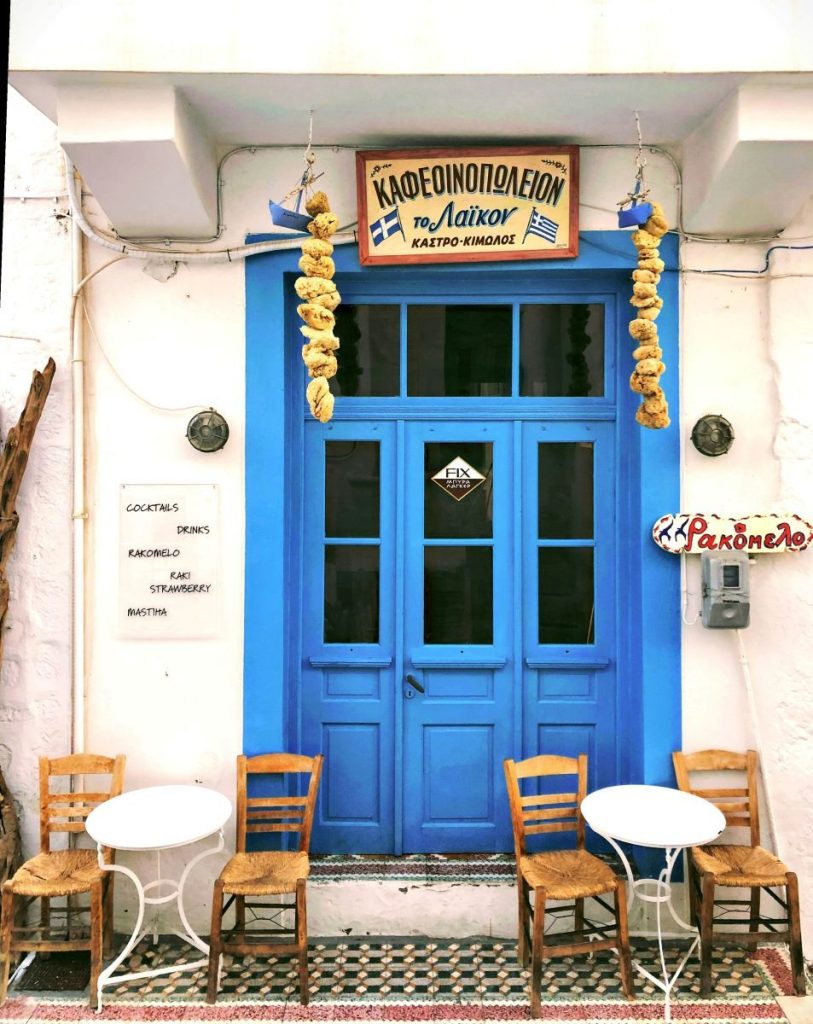
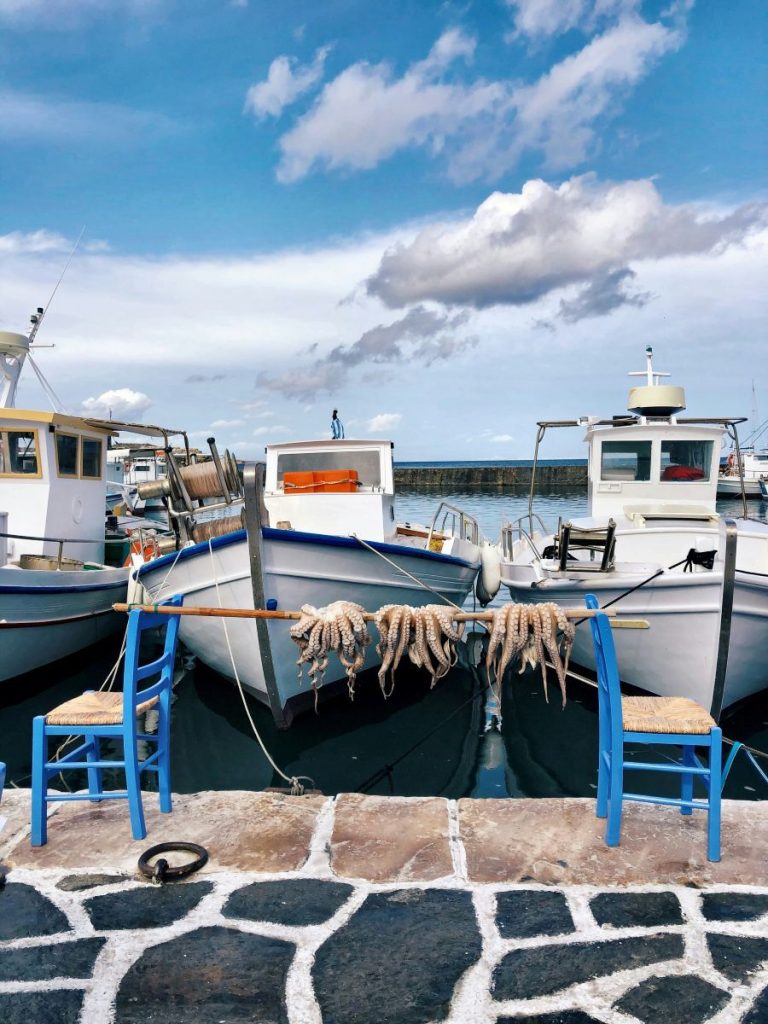
- Tzatziki: This fresh and creamy Greek yogurt is a must-have with its blend of cucumber, garlic, and dill. It’s usually served as an appetizer, accompanied by warm pita bread, perfect for generous dipping.
- Dolmades: Delicate grape leaves stuffed with rice, aromatic herbs, sometimes minced meat, and cooked to perfection. They are eaten cold or warm, often with a drizzle of lemon.
- Moussaka: A hearty gratin of eggplant, spiced minced meat, all topped with a creamy béchamel sauce. There are several variations of this dish across the Middle East and the Balkans.
- Spanakopita: A savory, crispy pie made of thin layers of phyllo dough and stuffed with a mixture of spinach, feta cheese, onions, and fresh herbs.
- Fasolakia: A dish of fresh green beans, stewed in a flavorful tomato sauce, scented with olive oil. It’s a typical vegetarian dish of Greek cuisine, omnipresent in the tavernas of small coastal towns.
- Keftedes: Greek meatballs, usually made from beef or lamb, seasoned with mint and parsley. They are fried and served as an appetizer or main course.
- Dakos: A Cretan specialty based on paximadi, a dry barley rusk, topped with crushed tomatoes, mizithra cheese, and oregano. A delight to enjoy on a terrace facing the sea in Crete!
- Gemista: Sun-ripened vegetables, such as peppers or tomatoes, slowly simmered in the oven and stuffed with rice and aromatic herbs. It’s an emblem of Greek family cooking in the Peloponnese region.
- Grilled Octopus: Often caught that very morning, they are hung to dry in the sun before being grilled over charcoal. Simply drizzled with olive oil and lemon, they are a specialty of Greek islands like Mykonos, Santorini, or Paros.
- Loukoumades: These are small, round, golden fried doughnuts, soaked in honey and sprinkled with cinnamon. Perfect for a dessert on the go!
The traditional cuisine of Italy
Italian gastronomic culture is a matter of passion and unchangeable traditions, with one of the highest numbers of AOCs (Appellations d’Origine Contrôlée) in the world. This testifies to a deep respect for the product and a friendly competition between regions to see where the best food is found. The number of emblematic dishes is so vast it’s difficult to summarize; each region multiplies into an infinity of specialties. For a true Mediterranean immersion, you must turn to the southern regions and port cities, where the sea dictates the rhythm of the seasons and flavors.
From Liguria to Sardinia, passing through Puglia and Sicily… in all cases, it’s best to plan for clothes with elastic waistbands. That’s our little pro tip!


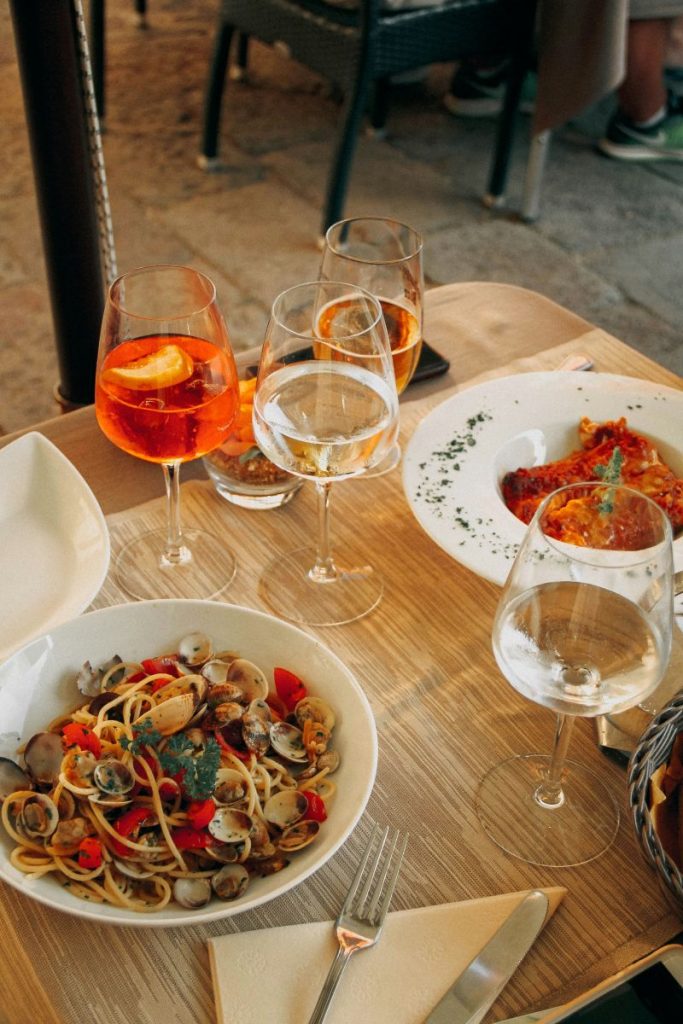
- Orecchiette con le cime di rapa: This emblematic dish from Puglia is an excellent example of local cuisine. The “little ear” pasta is served with turnip greens and garlic, all sautéed in a pan with extra virgin olive oil. A touch of peperoncino (chili pepper) is sometimes added for a kick.
- Arancini: These fried rice balls, stuffed with ragù sauce or mozzarella, are a Sicilian specialty.
- Fritto misto di mare: This dish is a must-have in small coastal taverns, consisting of small calamari, shrimp, and fish, all breaded and fried.
- Farinata: A thin and crispy chickpea flour pancake, baked in the oven and seasoned with salt, pepper, and rosemary. It’s the ultimate street food in Liguria, sometimes served with small anchovies.
- Cacciucco: A traditional fish soup from the port city of Livorno in Tuscany. This rustic dish is prepared with several types of fish and seafood, cooked in a spicy tomato sauce. It is served with slices of garlic-toasted bread, perfect for dipping.
- Focaccia barese: Each region of Italy has its own version of focaccia, but we have a soft spot for the one from Puglia, which is very soft and topped with cherry tomatoes and olives.
- Pasta con le sarde: A specialty from Sicily, this recipe is a true culinary journey. The pasta (often bucatini) is mixed with a sauce made from fresh sardines, wild fennel, pine nuts, raisins, and a touch of saffron.
- Pizza Margherita: The real pizza comes from only one place: Naples, in the Campania region. A thin, soft crust, San Marzano tomato sauce, buffalo mozzarella, a few fresh basil leaves, and a drizzle of olive oil. Simple, perfect, inimitable.
- Carciofi alla Giudia: A specialty of Rome’s Jewish community, this recipe features artichokes. The vegetables are fried whole in olive oil, making them crispy on the outside and tender on the inside, like a golden flower.
- Cannoli: Originally from Sicily, it is an absolute must-have. These are tubes of fried, crispy dough, filled with a sweet ricotta cream. And you know what the Godfather said about this dessert… “Leave the gun, take the cannolis.”
The traditional cuisine of Morocco
Moroccan gastronomy is a festival of flavors and colors, a bridge between Africa and the Mediterranean, the result of a melting pot of Berber, Arab, Andalusian, and Jewish influences. Along its coasts, the cuisine takes on a unique dimension, marrying oriental spices with the freshness of seafood. What particularly distinguishes it is the art of balancing sweet and savory flavors; dried fruits like dates and prunes, or spices like cinnamon and saffron, are used to enhance and perfume meats and fish. Complex blends like ras el-hanout give the dishes their unique aromatic depth.
In Morocco, meals are above all moments of sharing and generosity, whether in the frenzy of a souk or the calm of an intimate, dimly lit restaurant. In both scenarios, it’s a memorable experience!
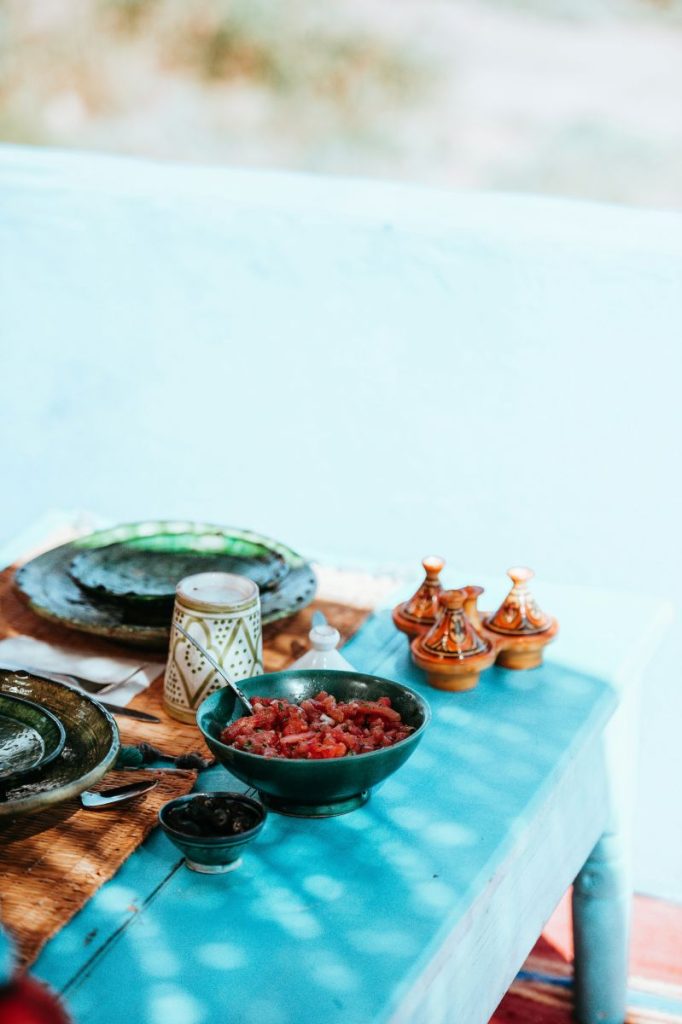

- Fish Tajine: While chicken tajine is known to all, fish tajine is a specialty of port cities like Essaouira or Agadir. Caught that very morning, the fish is cooked slowly with seasonal vegetables, tomatoes, fresh coriander, preserved lemon, and spices like cumin and paprika.
- Pastilla: An incredibly delicate layered pie that combines sweet and savory. The most famous version is made with pigeon and almonds, dusted with powdered sugar and cinnamon. Legend has it that it was a Spanish import to Morocco by the Moors who fled Andalusia.
- Harira: A hearty and comforting soup, traditionally eaten to break the fast during Ramadan. It is rich in lentils, chickpeas, tomatoes, and fresh herbs.
- Briouates: These small, crispy triangles, made from brick pastry, can be either sweet (almonds) or savory (minced meat, vegetables, cheese).
- Kefta de sardine: A specialty of the Moroccan coast, especially Essaouira, where sardines are minced and mixed with spices, coriander, and parsley to form meatballs. They are then cooked in a flavorful tomato sauce.
- Mint Tea: A social ritual! Served with elegance, tea is the symbol of hospitality and is enjoyed at any time of the day, whether in the riads of Marrakech or on the terraces of cafes in Chefchaouen.
- Baklava: Baklava is an emblematic layered pastry from the Middle East, the Balkans, and the Maghreb. It consists of thin layers of phyllo dough, generously filled with nuts, all soaked in a sweet syrup often flavored with cinnamon.
The traditional cuisine of Spain
Spanish gastronomy is a hymn to the joy of living, especially on its Mediterranean coasts. Here, cuisine is an art of living that stretches over sun-drenched days. Meals are taken late, at the hour when the heat softens and the terraces come alive. It is a time for conviviality and sharing: small dishes are served and are plentiful, inviting everyone to share from the center of the table. From Catalonia to Andalusia, each coastal region has its own culinary treasure to offer.
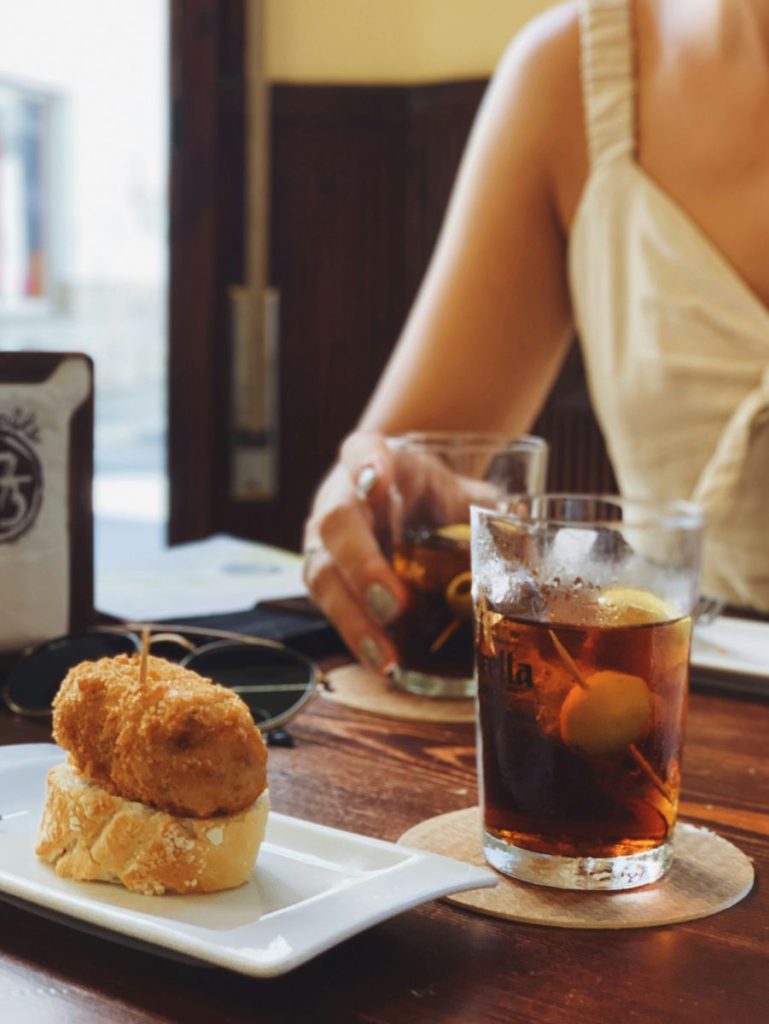
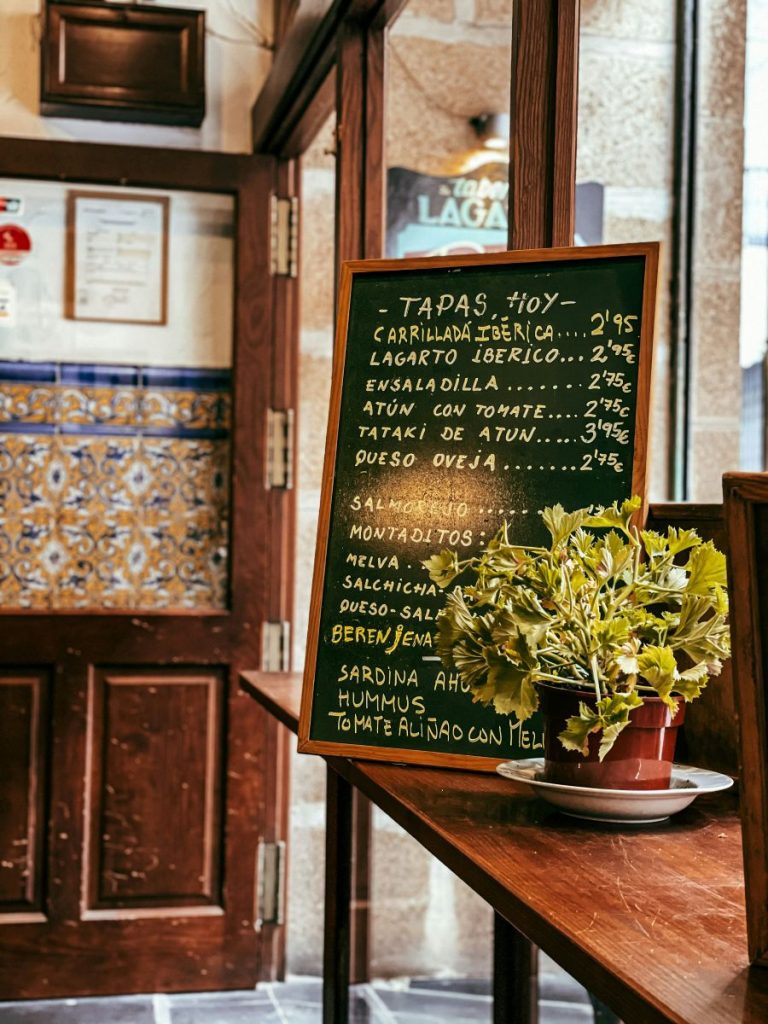
- Paella Valenciana: The real paella only comes from the Valencia region. There, we said it! Its traditional recipe does not include seafood, but rather chicken, rabbit, green beans, and garrofó (a local variety of white bean). Cooked in a large pan over an open flame, it is the quintessential Sunday family meal.
- Espetos de sardinas: Freshly caught sardines, skewered on a cane stick and grilled over a wood fire directly on the beach. An Andalusian tradition.
- Horchata: This is a sweet and refreshing Valencian drink made from tiger nuts, served iced to combat the summer heat. It is enjoyed with fartons, elongated pastries perfect for dipping!
- Esqueixada de bacallà: A refreshing Catalan salad of shredded cod with tomatoes, onions, and black olives.
- Pan con tomate: A Catalan specialty of disarming simplicity! It’s grilled country bread on which you rub a garlic clove and a ripe, juicy tomato, and generously drizzle with extra virgin olive oil and a pinch of salt.
- Gambas al ajillo: A tapas classic! Shrimp are sautéed in a clay pan with garlic, olive oil, and chili, and served sizzling hot.
- Gazpacho Andaluz: This cold soup, originally from Andalusia, is the epitome of a summer meal. Made with tomatoes, cucumbers, peppers, onions, and garlic, all blended with olive oil and vinegar, it is enjoyed all over southern Spain to fight the heat.
- Arroz Negro: A popular rice dish in Catalonia and Valencia. It gets its black color from squid ink and is cooked with squid and other seafood. It’s an alternative to paella with a very distinctive taste.








